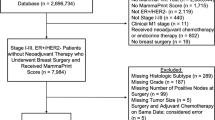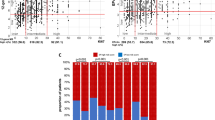Abstract
Purpose
Genomic expression assays provide prognostic information and guide adjuvant chemotherapy decisions for patients with estrogen receptor (ER)-positive breast cancer. Few studies have evaluated the utility of such assays for invasive lobular carcinoma (ILC). The objective of this study is to evaluate the 70-gene signature test (ST) as a prognostic and predictive tool for ILC using a national cancer database.
Methods
We identified patients diagnosed with stage I–III ER-positive ILC from 2004 to 2016 using the National Cancer Database. All patients underwent 70-gene ST testing. We used the Kaplan–Meier method and Cox proportional hazard analyses to determine overall survival based on genomic risk classification. We also determined the benefit of adjuvant chemotherapy for patients with high-genomic risk ILC based on 70-gene ST testing.
Results
We identified 2610 patients with ILC who underwent 70-gene ST testing; 280 (11%) were classified as high genomic risk. Five-year overall survival rates were significantly worse for patients classified as high risk (83%) as compared with those classified as low risk (94%, p < 0.05). In Cox models, high genomic risk was independently associated with a significantly increased hazard of death. In our Cox models of patients who were high genomic risk, adjuvant chemotherapy was not significantly associated with improved overall survival.
Conclusion
In this large database study, we found that the genomic risk category determined by the 70-gene ST was significantly associated with survival outcomes for patients with ILC. However, the 70-gene ST failed to predict the benefit of adjuvant chemotherapy for patients with high genomic risk.


Similar content being viewed by others
Data availability
De-identified data used in this study were obtained from the National Cancer Database (NCDB).
Code availability
Not applicable.
References
Lakhani SR, Ellis IO, Schnitt S, Tan PH, van de Vijver M (2012) WHO classification of tumours of the breast. IARC Publications, Lyon
Li CI, Uribe DJ, Daling JR (2005) Clinical characteristics of different histologic types of breast cancer. Br J Cancer 93(9):1046–1052
Pestalozzi BC, Zahrieh D, Mallon E et al (2008) Distinct clinical and prognostic features of infiltrating lobular carcinoma of the breast: combined results of 15 International Breast Cancer Study Group clinical trials. J Clin Oncol 26(18):3006–3014
Wang J, Mittendorf EA, Sahin AA et al (2014) Outcomes of sentinel lymph node dissection alone vs axillary lymph node dissection in early stage invasive lobular carcinoma: a retrospective study of the surveillance, epidemiology and end results (SEER) database. PLoS ONE 9(2):e89778
Marmor S, Hui JYC, Huang JL et al (2017) Relative effectiveness of adjuvant chemotherapy for invasive lobular compared with invasive ductal carcinoma of the breast. Cancer 123:3015–3021
Sparano JA, Gray RJ, Makower DF et al (2018) Adjuvant chemotherapy guided by a 21-gene expression assay in breast cancer. N Engl J Med 379(2):111–121
Cardoso F, Veer LJVT, Bogaerts J et al (2016) 70-Gene signature as an aid to treatment decisions in early-stage breast cancer. N Engl J Med 375(8):717–729
Chin K, DeVries S, Fridlyand J et al (2006) Genomic and transcriptional aberrations linked to breast cancer pathophysiologies. Cancer Cell 10(6):529–541
Kizy S, Huang JL, Marmor S et al (2017) Impact of the 21-gene recurrence score on outcome in patients with invasive lobular carcinoma of the breast. Breast Cancer Res Treat 165(3):757–763
Beumer IJ, Persoon M, Witteveen A et al (2016) Prognostic value of MammaPrint® in invasive lobular breast cancer. Biomark Insights 11:139–146
Bhutiani N, Egger ME, Ajkay N et al (2018) Multigene signature panels and breast cancer therapy: patterns of use and impact on clinical decision making. J Am Coll Surg. https://doi.org/10.1016/j.jamcollsurg.2017.12.043
Metzger O, Cardoso F et al (2020) Clinical utility of MammaPrint testing in invasive lobular carcinoma: results from the MINDACT phase III trial. Eur J Cancer. https://doi.org/10.1016/s0959-8049(20)30542-6
NCCN (2020) Breast Cancer. https://www.nccn.org/professionals/physician_gls/pdf/breast.pdf accessed 24 Dec 2020
Borst MJ, Ingold JA (1993) Metastatic patterns of invasive lobular versus invasive ductal carcinoma of the breast. Surgery 114(4):637–642
Inoue M, Nakagomi H, Nakada H, Furuya K, Ikegame K, Watanabe H, Oyama T (2017) Specific sites of metastases in invasive lobular carcinoma: a retrospective cohort study of metastatic breast cancer. Breast Cancer 24(5):667–672. https://doi.org/10.1007/s12282-017-0753-4
McCart Reed AE, Kutasovic JR, Lakhani SR, Simpson PT (2015) Invasive lobular carcinoma of the breast: morphology, biomarkers and ’omics. Breast Cancer Res 17(1):12
Desmedt C, Zoppoli G, Gundem G et al (2016) Genomic characterization of primary invasive lobular breast cancer. J Clin Oncol 34(16):1872–1881
Acknowledgements
The authors acknowledge Doug Yee, MD for his guidance and review and editing of this manuscript.
Funding
Not applicable.
Author information
Authors and Affiliations
Corresponding author
Ethics declarations
Conflict of interest
Not applicable.
Ethical approval
This study was exempt from the University of Minnesota institutional review board as only de-identified data were used.
Consent to participate
Not applicable.
Consent for publication
Not applicable.
Additional information
Publisher's Note
Springer Nature remains neutral with regard to jurisdictional claims in published maps and institutional affiliations.
Appendix
Appendix
See Table 4.
Rights and permissions
About this article
Cite this article
Jenkins, J.A., Marmor, S., Hui, J.Y.C. et al. The 70-gene signature test as a prognostic and predictive biomarker in patients with invasive lobular breast cancer. Breast Cancer Res Treat 191, 401–407 (2022). https://doi.org/10.1007/s10549-021-06429-8
Received:
Accepted:
Published:
Issue Date:
DOI: https://doi.org/10.1007/s10549-021-06429-8




